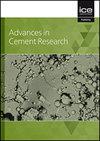Effect of temperature and clinker content on hydration and strength development of calcined clay blends
IF 1.3
4区 工程技术
Q3 CONSTRUCTION & BUILDING TECHNOLOGY
引用次数: 4
Abstract
The effect of curing temperatures: 10°C, 27°C and 50°C, on hydration kinetics, phase assemblages and strength development of blends with calcined clay was investigated at two replacement levels. The temperature sensitivity of the blends significantly increased when the clinker is replaced with calcined clay, even at a 30% replacement level. The compressive strength development in calcined clay blends was higher than that of OPC at a lower temperature, perhaps due to formation of low-density products such as stratlingite, rather than enhanced clinker hydration. The reduced compressive strength development at 50°C for calcined clay blends could be due to multiple reasons such as lower clinker hydration, reduced pozzolanic reaction, and reduced stability of carboaluminates and ettringite. However, merely a 24-hour lag in this temperature exposure reverses this temperature effect, mainly due to the enhanced stability of carboaluminates and ettringite phases. It is seen that the reduction in hydration is mainly in the belite phase and could be due to the large changes in the C-A-S-H having a high alumina substitution. It is hypothesised that the adverse effect of high-temperature exposure in calcined clay blends is due to the formation of a physical barrier of highly polymerised C-S-H on the surface of the unhydrated clinker. The improved performance due to the delay in high-temperature exposure could be due to the enhanced stability of ettringite and carboaluminate phases.温度和熟料含量对煅烧粘土混合物水化和强度发展的影响
研究了固化温度(10°C、27°C和50°C)对煅烧粘土共混物的水化动力学、相组合和强度发展的影响。当用煅烧粘土代替熟料时,即使在30%的替代水平下,共混物的温度敏感性也显著提高。在较低的温度下,煅烧粘土混合物的抗压强度发展高于OPC,这可能是由于形成了低密度产物,如层状岩,而不是增强了熟料的水合作用。煅烧粘土混合物在50°C下抗压强度的降低可能是由于多种原因造成的,如熟料水合作用降低、火山灰反应减少以及碳铝酸盐和钙矾石的稳定性降低。然而,这种温度暴露仅24小时的滞后就逆转了这种温度效应,这主要是由于碳铝酸盐和钙矾石相的稳定性增强。可以看出,水合作用的减少主要在贝利特相中,并且可能是由于具有高氧化铝取代度的C-A-S-H的大变化。据推测,煅烧粘土混合物中高温暴露的不利影响是由于在未脱水的熟料表面形成了高度聚合的C-S-H的物理屏障。高温暴露延迟导致的性能改善可能是由于钙矾石和碳铝酸盐相的稳定性增强。
本文章由计算机程序翻译,如有差异,请以英文原文为准。
求助全文
约1分钟内获得全文
求助全文
来源期刊

Advances in Cement Research
工程技术-材料科学:综合
CiteScore
3.70
自引率
5.00%
发文量
56
审稿时长
3.2 months
期刊介绍:
Advances in Cement Research highlights the scientific ideas and innovations within the cutting-edge cement manufacture industry. It is a global journal with a scope encompassing cement manufacture and materials, properties and durability of cementitious materials and systems, hydration, interaction of cement with other materials, analysis and testing, special cements and applications.
 求助内容:
求助内容: 应助结果提醒方式:
应助结果提醒方式:


